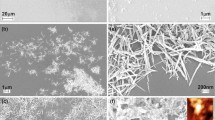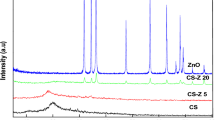Abstract
In this work, the one-step synthesis of multicomponent polymer nanocomposites containing zinc oxide and cuprous oxide nanoparticles based on chitosan and polyvinyl alcohol was investigated using underwater pulsed discharge plasma. Direct initiation of electrical discharge between metal electrodes in a polymer solution enables reagent-free obtaining of metal oxide nanoparticles with an average diameter of about 30 nm. Transmission electron microscopy observations showed °that metal oxide nanoparticles uniformly dispersed in polymer matrix. It has been established that a partial destruction of chitosan occurs with the formation of glucosamine, N-acetylglucosamine, and delta-mannitol under the action of the discharge. The polymer film containing 0.35% Cu2O and 3.41% ZnO nanoparticles demonstrated the highest antimicrobial activity Escherichia coli, Staphylococcus albicans, and Bacillus subtilis.









Similar content being viewed by others
References
Zhou K, Wang R, Xu B, Li Y (2006) Synthesis, characterization and catalytic properties of CuO nanocrystals with various shapes. Nanotechnology 17:3939
Fernandez-Garcia M, Martinez-Arias A, Hanson JC, Rodriguez JA (2004) Nanostructured oxides in chemistry: characterization and properties. Chem Rev 104(9):4063–4104
Inoue KI, Takano H, Yanagisawa R, Koike E, Shimada A (2009) Size effects of latex nanomaterials on lung inflammation in mice. Toxicol Appl Pharmacol 234(1):68–76
Khashan KS, Sulaiman GM, Abdulameer FA (2016) Synthesis and antibacterial activity of CuO nanoparticles suspension induced by laser ablation in liquid. Arab J Sci Eng 41(1):301–310
Park THJ, Joo J, Kwon SG, Jang Y (2007) Synthesis of monodisperse spherical nanocrystals. Angew Chem Int Ed Engl 46:4630–4660
Marabelli F, Parravicini GB, Salghetti-Drioli F (1995) Optical gap of CuO. Phys Rev B 52(3):1433
El-Trass A, ElShamy H, El-Mehasseb I, El-Kemary M (2012) CuO nanoparticles: synthesis, characterization, optical properties and interaction with amino acids. Appl Surf Sci 258(7):2997–3001
Ferdous Z, Nemmar A (2020) Health impact of silver nanoparticles: a review of the bio distribution and toxicity following various routes of exposure. Int J Mol Sci 21(7):2375
Yousef JM, Danial EN (2012) In vitro antibacterial activity and minimum inhibitory concentration of zinc oxide and nano-particle zinc oxide against pathogenic strains. J Health Sci 2(4):38–42
Verdier T, Coutand M, Bertron A, Roques C (2014) Antibacterial activity of TiO2 photocatalyst alone or in coatings on E. coli: the influence of methodological aspects. Coatings 4(3):670–686
Kumar A, Pandey AK, Singh SS, Shanker R, Dhawan A (2011) Cellular response to metal oxide nanoparticles in bacteria. J Biomed Nanotechnol 7(1):102–103
Kumar A, Pandey AK, Singh SS, Shanker R, Dhawan A (2011) Engineered zinc oxide and titanium dioxide nanoparticles induce oxidative stress and DNA damage leading to reduced viability of Escherichia coli. Free Radic Biol Med 51:1872–1881
Keller AA, Wang H, Zhou D, Lenihan HS, Cherr G, Cardinale BJ, Ji Z (2010) Stability and aggregation of metal oxide nanoparticles in natural aqueous matrices. Environ Sci Technol 44(6):1962–1967
Tso CP, Zhung CM, Shih YH, Tseng YM, Wu SC, Doong RA (2010) Stability of metal oxide nanoparticles in aqueous solutions. Water Sci Technol 61(1):127–133
Sarkar S, Guibal E, Quignard F, SenGupta AK (2012) Polymer-supported metals and metal oxide nanoparticles: synthesis, characterization, and applications. J Nanopart Res 14(2):1–24
Li Q, Dunn ET, Grandmaison EW, Goosen MF (1992) Applications and properties of chitosan. J Bioact Compat Polym 7(4):370–397
Liang Y, Zhao X, Ma PX, Guo B, Du Y, Han X (2019) pH-responsive injectable hydrogels with mucosal adhesiveness based on chitosan-grafted-dihydrocaffeic acid and oxidized pullulan for localized drug delivery. J Colloid Interface Sci 536:224–234
Zhao X, Li P, Guo B, Ma PX (2015) Antibacterial and conductive injectable hydrogels based on quaternized chitosan-graft-polyaniline/oxidized dextran for tissue engineering. Acta Biomater 26:236–248
Rinaudo M (2006) Chitin and chitosan: properties and applications. Prog Polym Sci 31(7):603–632
Zhao X, Wu H, Guo B, Dong R, Qiu Y, Ma PX (2017) Antibacterial anti-oxidant electroactive injectable hydrogel as self-healing wound dressing with hemostasis and adhesiveness for cutaneous wound healing. Biomaterials 122:34–47
Perelshtein I, Ruderman E, Perkas N, Tzanov T, Beddow J, Joyce E, Gedanken A (2013) Chitosan and chitosan–ZnO-based complex nanoparticles: formation, characterization, and antibacterial activity. J Mater Chem B 1(14):1968–1976
Mbhele ZH, Salemane MG, Van Sittert CGCE, Nedeljković JM, Djoković V, Luyt AS (2003) Fabrication and characterization of silver− polyvinyl alcohol nanocomposites. Chem Mater 15(26):5019–5024
Jannesari M, Varshosaz J, Morshed M, Zamani M (2011) Composite poly (vinyl alcohol)/poly (vinyl acetate) electrospun nanofibrous mats as a novel wound dressing matrix for controlled release of drugs. Int J Nanomed 6:993
Venkataprasanna KS, Prakash J, Vignesh S, Bharath G, Venkatesan M, Banat F, Venkatasubbu GD (2020) Fabrication of Chitosan/PVA/GO/CuO patch for potential wound healing application. Int J Biol Macromol 143:744–762
Baghaie S, Khorasani MT, Zarrabi A, Moshtaghian J (2017) Wound healing properties of PVA/starch/chitosan hydrogel membranes with nano Zinc oxide as antibacterial wound dressing material. J Biomater Sci Polym Ed 28(18):2220–2241
Khorasani MT, Joorabloo A, Adeli H, Milan PB, Amoupour M (2021) Enhanced antimicrobial and full-thickness wound healing efficiency of hydrogels loaded with heparinized ZnO nanoparticles: in vitro and in vivo evaluation. Int J Biol Macromol 166:200–212
Abdeen ZI, El Farargy AF, Negm NA (2018) Nanocomposite framework of chitosan/polyvinyl alcohol/ZnO: preparation, characterization, swelling and antimicrobial evaluation. J Mol Liq 250:335–343
Sirotkin NA, Khlyustova AV, Titov VA, Krayev AS, Nikitin DI, Dmitrieva OA, Agafonov AV (2020) Synthesis and photocatalytic activity of WO3 nanoparticles prepared by underwater impulse discharge. Plasma Chem Plasma Process 40(2):571–587
Khlyustova A, Sirotkin N, Kraev A, Titov V, Agafonov A (2021) Parameters of underwater plasma as a factor determining the structure of oxides (Al, Cu, and Fe). Materialia 16:101081
Khlyustova AV, Sirotkin NA, Kraev AS, Titov VA, Agafonov AV (2021) Synthesis and characterization of titanium oxide nanoparticles by plasma in contact with liquid. Plasma Chem Plasma Process 41(2):643–657
Morent R, De Geyter N, Verschuren J, De Clerck K, Kiekens P, Leys C (2008) Non-thermal plasma treatment of textiles. Surf Coat Technol 202(14):3427–3449
Joshi R, Schulze RD, Meyer-Plath A, Friedrich JF (2008) Selective surface modification of poly (propylene) with OH and COOH groups using liquid-plasma systems. Plasma Processes Polym 5(7):695–707
Khlyustova A, Sirotkin N, Kraev A, Agafonov A, Titov V (2021) Effect of metal oxides added onto polyvinyl alcohol via pulsed underwater plasma on their thermal, electrical and dielectric properties. J Appl Polym Sci 138(40):51174
Sirotkin NA, Gurina DL, Khlyustova AV, Costerin DY, Naumova IK, Titov VA, Agafonov AV (2021) Experimental and computational investigation of polylactic acid/silver-NP nanocomposite with antimicrobial activity prepared by plasma in liquid. Plasma Processes Polym 18(2):2000169
Sirotkin N, Khlyustova A, Costerin D, Naumova I, Titov V, Agafonov A (2022) Applications of plasma synthesized ZnO, TiO2, and Zn/TiOx nanoparticles for making antimicrobial wound-healing viscose patches. Plasma Processes Polym 19(1):100093
Sekhon JS, Verma SS (2011) Cu, CuO, and Cu2O nanoparticle plasmons for enhanced scattering in solar cells. In: Taylor A (ed) Renewable energy and the environment, OSA technical digest (CD). Optica Publishing Group, paper JWE22
Ogawa K, Yui T (1994) Effect of explosion on the crystalline polymorphism of chitin and chitosan. Biosci Biotechnol Biochem 58(5):968–969
Samuels RJ (1981) Solid state characterization of the structure of chitosan films. J Polym Sci Polym Phys Ed 19(7):1081–1105
Torrado S, Torrado S (2002) Characterization of physical state of mannitol after freeze-drying: effect of acetylsalicylic acid as a second crystalline cosolute. Chem Pharm Bull 50(5):567–570
Miri A, Mahdinejad N, Ebrahimy O, Khatami M, Sarani M (2019) Zinc oxide nanoparticles: biosynthesis, characterization, antifungal and cytotoxic activity. Mater Sci Eng C 104:109981
Khatami M, Alijani HQ, Heli H, Sharifi I (2018) Rectangular shaped zinc oxide nanoparticles: green synthesis by stevia and its biomedical efficiency. Ceram Int 44(13):15596–15602
Kooti M, Matouri L (2010) Fabrication of nanosized cuprous oxide using fehling’s solution. Trans F Nanotechnol 17:73–78
Khowdiary MM, El-Henawy AA, Shawky AM, Sameeh MY, Negm NA (2017) Synthesis, characterization and biocidal efficiency of quaternary ammonium polymers silver nanohybrids against sulfate reducing bacteria. J Mol Liq 230:163–168
Titov V, Nikitin D, Naumova I, Losev N, Lipatova I, Kosterin D, Pleskunov P, Perekrestov R, Sirotkin N, Khlyustova A, Agafonov A, Choukourov A (2020) Dual-mode solution plasma processing for the production of chitosan/Ag composites with the antibacterial effect. Materials 13(21):4821
Khlyustova A, Sirotkin N, Naumova I, Tarasov A, Titov V (2022) Solution plasma processing as an environmentally friendly method for low-molecular chitosan production. Plasma Chem Plasma Process 42:1–17
Ali M, Gherissi A (2017) Synthesis and characterization of the composite material PVA/chitosan/5% sorbitol with different ratio of chitosan. Int J Mech Mechatron Eng 17:15–28
Bhadra P, Mitra MK, Das GC, Dey R, Mukherjee S (2011) Interaction of chitosan capped ZnO nanorods with Escherichia coli. Mater Sci Eng C 31(5):929–937
Finch CA (1973) Polyvinyl alcohol; properties and applications. John Wiley & Sons
Khan I, Tango CN, Miskeen S, Oh DH (2018) Evaluation of nisin-loaded chitosan-monomethyl fumaric acid nanoparticles as a direct food additive. Carbohydr Polym 184:100–107
Sreenivasan K (1996) Thermal stability studies of some chitosanmetal ion complexes using differential scanning calorimetry. Polym Degrad Stab 52(1):85–87
Vijaya Kumar R, Elgamiel R, Diamant Y, Gedanken A, Norwig J (2001) Sonochemical preparation and characterization of nanocrystalline copper oxide embedded in poly (vinyl alcohol) and its effect on crystal growth of copper oxide. Langmuir 17(5):1406–1410
Abdelaziz M (2011) Cerium (III) doping effects on optical and thermal properties of PVA films. Physica B 406(6–7):1300–1307
Ma X, Su Y, Sun Q, Wang Y, Jiang Z (2007) Enhancing the antifouling property of polyethersulfone ultrafiltration membranes through surface adsorption-crosslinking of poly (vinyl alcohol). J Membr Sci 300(1–2):71–78
Liu R, Xu X, Zhuang X, Cheng B (2014) Solution blowing of chitosan/PVA hydrogel nanofiber mats. Carbohyd Polym 101:1116–1121
Kowalczyk SP, Ley L, McFeely FR, Pollak RA, Shirley DA (1974) Relative effect of extra-atomic relaxation on auger and binding-energy shifts in transition metals and salts. Phys Rev B 9(2):381
Espitia PJP, Soares NFF, Coimbra JSR, de Andrade NJ, Cruz RS (2012) Zinc oxide nanoparticles: synthesis, antimicrobial activity and food packaging applications. Food Bioprocess Technol 5:1447–1464
Pan T, Song W, Cao X, Wang Y (2016) 3D bioplotting of gelatin/alginate scaffolds for tissue engineering: influence of crosslinking degree and pore architecture on physicochemical properties. J Mater Sci Technol 32(9):889–900
Nie L, Chen D, Suo J, Zou P, Feng S, Yang Q, Ye S (2012) Physicochemical characterization and biocompatibility in vitro of biphasic calcium phosphate/polyvinyl alcohol scaffolds prepared by freeze-drying method for bone tissue engineering applications. Coll Surf B 100:169–176
Tsai GJ, Su WH (1999) Antibacterial activity of shrimp chitosan against Escherichia coli. J Food Prot 62(3):239–243
Nel A, Xia T, Madler L, Li N (2006) Toxic potential of materials at the nanolevel. Science 311(5761):622–627
Ravishankar RV, Jamuna BA (2011) Nanoparticles and their potential application as antimicrobials. In: Méndez V (ed) Science against microbial pathogens, communicating current research and technological advances. Badajoz, Formatex, pp 197–209
Cleetus CM, Primo FA, Fregoso G, Raveendran NL, Noveron JC, Spencer CT, Joddar B (2020) Alginate hydrogels with embedded ZnO nanoparticles for wound healing therapy. Int J Nanomed 15:5097–5111
Acknowledgements
This work was performed in the frame of the Government Assignment of the Ministry of Education and Science of Russia (no. 0092-2019-0003). The authors thank Dr. N. Fomina for performing XRD analyses, Dr. Yu. Fadeeva for conducting FTIR measurements and Dr. S. Guseinov for conducting thermogravimetric analysis at the Center for Sharing Scientific Equipment (the Upper Volga Regional Center for physico-chemical research, Russia), Dr. M. Voronova and Dr. N. Tabachkova for conducting TEM analysis at the center of joint use of scientific equipment (the Materials Science and Metallurgy, National University of Science and Technology MISIS).
Author information
Authors and Affiliations
Corresponding author
Ethics declarations
Conflicts of interest
The authors declare no competing interests.
Additional information
Publisher's Note
Springer Nature remains neutral with regard to jurisdictional claims in published maps and institutional affiliations.
Rights and permissions
About this article
Cite this article
Sirotkin, N., Khlyustova, A., Costerin, D. et al. Synthesis of chitosan/PVA/metal oxide nanocomposite using underwater discharge plasma: characterization and antibacterial activities. Polym. Bull. 80, 5655–5674 (2023). https://doi.org/10.1007/s00289-022-04348-2
Received:
Revised:
Accepted:
Published:
Issue Date:
DOI: https://doi.org/10.1007/s00289-022-04348-2




